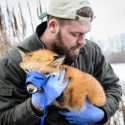UW-Madison scientists create super-strong collagen
A team of University of Wisconsin–Madison researchers has created the strongest form of collagen known to science, a stable alternative to human collagen that could one day be used to treat arthritis and other conditions that result from collagen defects.
“It’s by far the most stable collagen ever made,” says Ron Raines, a University of Wisconsin–Madison professor of chemistry and biochemistry who led the study, published in the Jan. 12 issue of the Proceedings of the National Academy of Sciences.
Collagen is the most abundant protein in the human body, forming strong sheets and cables that support the structure of skin, internal organs, cartilage and bones, as well as all the connective tissue in between. For decades, doctors have used collagen from cows to treat serious burns and other wounds in humans despite the risk of tissue rejection associated with cross-species transplants.
In 2006, Raines’ team figured out how to make human collagen in the lab, creating collagen molecules longer than any found in nature. Now, with funding from the National Institutes of Health, the researchers have taken this line of inquiry one step further, creating a form of super-strong collagen that may one day help millions. Raines says this artificial collagen holds promise as a therapy for conditions such as arthritis, which is caused by a breakdown of the body’s natural collagen and affects more than 46 million Americans.
To make the new form of collagen, Raines’ team substituted two-thirds of the protein’s regular amino acids with less-flexible versions that stiffened the overall structure of the protein and helped it hold its form. “The breakthrough of this approach was the use of rigid analogues that have shapes similar to [the shapes the natural amino acids take] in the folded, functional form of the protein,” explains Raines.
The resulting collagen holds together at temperatures far above what it takes for natural collagen to fall apart. And although it’s built largely from amino acids that aren’t found in nature, X-ray crystallography confirms that the three-dimensional structure of the lab-made collagen is indistinguishable from that of natural collagen, according to UW–Madison bacteriologist Katrina Forest, a co-author of the study.
“This hyper-stable collagen is really a testament to the power of modern protein chemistry,” says Raines.



